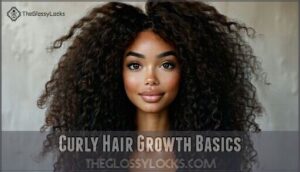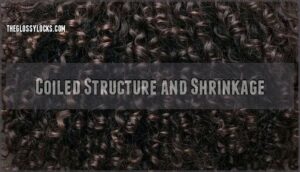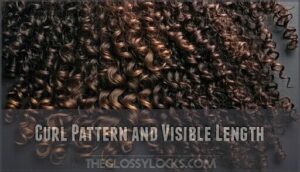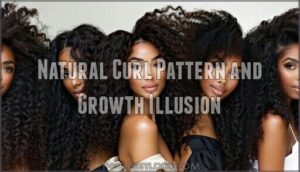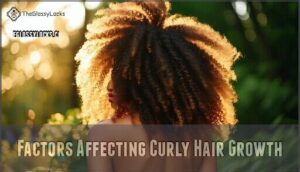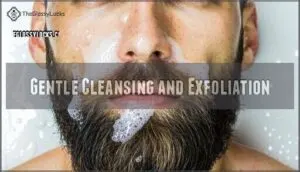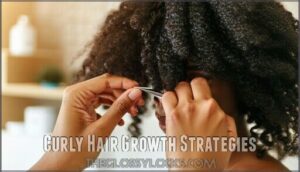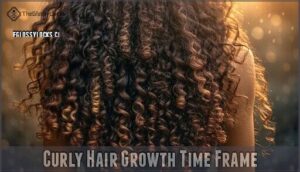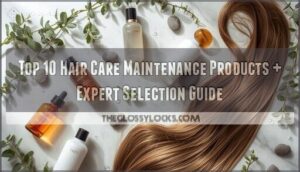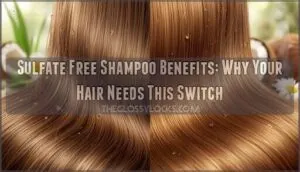This site is supported by our readers. We may earn a commission, at no cost to you, if you purchase through links.
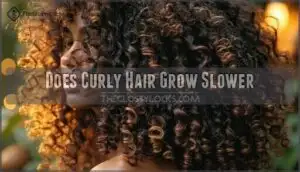
Think of it like a slinky—stretch it out, and it’s longer than it seems! Genetics, the hair growth cycle, and how you care for your hair all play a role in what you see.
Proper hydration, scalp care, and gentle handling can make a huge difference. Curious about keeping those curls thriving? There’s a science to it, and it’s worth exploring.
Table Of Contents
- Key Takeaways
- Curly Hair Growth Basics
- Does Curly Hair Grow Slower
- Curly Hair Perception Challenges
- Factors Affecting Curly Hair Growth
- Nurturing Curly Hair Growth
- Curly Hair Growth Strategies
- Curly Hair Growth Time Frame
- Optimizing Curly Hair Growth
- Frequently Asked Questions (FAQs)
- Which hair type takes the longest to grow?
- Is there any advantage to curly hair?
- Can hormonal changes affect curly hair growth?
- Does hair dye impact curly hair growth?
- How does pregnancy influence curly hair?
- Can stress cause curly hair loss?
- Does climate affect curly hair growth?
- What causes uneven growth rates in curly hair?
- Can environmental factors impact curly hair growth?
- How does porosity affect curly hair growth?
- Conclusion
Key Takeaways
- Curly hair grows at the same rate as straight hair—about half an inch per month—but its coiled structure and shrinkage can make it look shorter.
- Shrinkage hides actual length, with curls losing 30-75% of their real length when dry.
- Genetics control your hair’s growth potential, texture, and density, not your hair’s speed of growth.
- Proper care, like regular hydration, scalp health maintenance, and gentle handling, helps retain length and keeps your curls thriving.
Curly Hair Growth Basics
Your hair grows in three predictable phases—growth, regression, and rest—each controlled by your genetics.
While curly hair might seem slower to grow, it actually follows the same rate as other hair types, about half an inch per month, which is a predictable growth pattern.
Hair Growth Phases
Hair grows in a fascinating cycle with three key phases:
- Anagen Phase: The star of the show, where hair grows actively, influenced by genetics.
- Catagen Phase: A brief shift as growth pauses.
- Telogen Phase: Hair rests or sheds, making room for new growth.
- Hair follicles cycle independently, ensuring no surprises.
- Growth rate stays steady across hair types!
Anagen Phase Duration
The anagen phase, the longest part of your hair growth cycle, is where growth magic happens.
Genetic predisposition largely decides your phase length variation, dictating how long and fast hair grows.
This phase affects your growth potential and maximum length, as healthy hair follicles sustain activity.
While curly hair shares this process, its growth rate feels invisible due to coiled shapes.
Genetics Influence on Growth
Your DNA plays the lead role in curly hair growth.
Genetics shape your curls’ texture, growth potential, and pace—your DNA is the ultimate hair growth blueprint!
Genetics determine your hair’s texture, growth potential, and anagen duration, which controls how long hair grows before resting.
While growth cycles are universally steady, genetic predisposition shapes your hair density and follicles’ ability to grow.
So, whether your curls dazzle or shrink, blame—or thank—your genes for the pace and pattern!
This influence includes how genes affect texture and determines your overall hair growth.
Does Curly Hair Grow Slower
Many people wonder, “Does curly hair grow slower?” The answer is no—it doesn’t. The curly hair growth rate is identical to straight hair, at about half an inch per month.
However, curly hair’s coiling effects and the shrinkage illusion can make growth seem slower. Because curls naturally spring back, visible progress often appears minimal, especially compared to straighter textures.
This phenomenon, called visual progress, is further distorted by shrinkage, with curls losing 30-75% of their actual length when dry. While genetically determined, hair growth for curly hair can feel like a waiting game due to these unique challenges.
One reason for this perceived slower growth is that curly hair tends to trap normal shed strands until wash day. The key to length retention lies in safeguarding your strands from breakage, embracing patience, and trusting that your curls are indeed growing steadily.
Curly Hair Perception Challenges
You might think curly hair grows slower, but it’s really just an illusion caused by its coiled structure and shrinkage.
These tight curls and springy textures compress length, making progress harder to see compared to straighter strands. Complete concepts and separate lines are key.
Coiled Structure and Shrinkage
Curly hair grows at the same rate as straight hair, but the coiled texture creates a shrinkage illusion that tricks your eyes.
Shrinkage can make your hair appearance seem shorter, even when it’s growing steadily. This natural curl pattern hides visual progress, leading to a perception of growth stagnation.
Curly hair’s perceived desirability has changed with shifting fashion cycles. Remember, it’s growing—you just can’t see the length easily, due to the coiled texture and natural curl pattern.
Curl Pattern and Visible Length
A curly hair’s coiling effect often overshadows actual growth.
The spring-like curl pattern creates a shrinkage illusion, making length perception tricky. Even with steady hair growth, visual progress feels slower as curls hide true length.
Enhancing curl definition with proper care can help, but shrinkage often leaves you wondering where those extra inches seem to vanish.
Understanding follicle shape impacts the degree of curl.
Natural Curl Pattern and Growth Illusion
The unique curl pattern of curly hair can make it seem like it grows slower, even though it doesn’t.
The natural curl pattern creates an illusion of slower growth, but curls grow just as steadily as straight hair.
Shrinkage effects, caused by coiling perception, obscure hair length and visual progress.
This illusion stems from how curls fold and bounce back.
Length retention feels elusive, but consistent care improves curl definition and showcases actual growth.
- Shrinkage compresses hair, reducing visible length.
- Coiling hides progress between trims.
- Loose curls appear longer than tighter ringlets.
- Maintaining curl health enhances perceived growth.
This reorganization highlights that consistent care is key to improving curl definition and that understanding shrinkage is crucial for managing expectations about hair length.
Factors Affecting Curly Hair Growth
Your curly hair’s growth rate depends on factors like genetics, scalp health, and proper care, not its texture.
By understanding these influences, you can create habits that support healthy, consistent growth.
Genetics and Growth Rate
Your hair’s growth potential largely depends on genetics.
The anagen phase, or active growth period, is determined by your genetic predisposition.
Hair texture and density, shaped by your follicles, are also genetic factors.
While curly hair growth seems tricky, your anagen length and texture influence visual results—not actual growth.
Simply put, genetics drive your hair’s rate and structure, and understanding this can help you manage your hair’s growth.
Hair Care and Health Impact
Great hair care starts with hydration methods, scalp health, and using the right product ingredients.
Protective styling prevents breakage, while avoiding harsh hair care products can reduce chemical damage.
Does curly hair grow slower? It may seem that way, but neglecting hair health causes setbacks.
Prioritize quality hair care to boost growth and maintain strong, healthy curls, and understand that scalp health is crucial for overall hair well-being.
Scalp Care and Massage
A healthy scalp sets the stage for vibrant hair growth. Massaging your scalp boosts blood circulation, delivering nutrients to hair follicles. Plus, it feels pretty great—like a spa day for your head.
- Promote scalp health with gentle massage techniques.
- Improve product absorption by exfoliating weekly.
- Enhance hair follicle health using natural oils.
- Support steady hair growth with consistent care and natural oils.
Nurturing Curly Hair Growth
You can nurture curly hair growth by focusing on proper care and consistent healthy habits.
Providing your curls with the right balance of moisture, gentle cleansing, and nutrients keeps them strong and promotes steady growth.
Balanced Diet and Hydration
Eating right feeds your hair! A balanced diet rich in vitamins, minerals, and proteins supports curly hair growth by nourishing follicles and boosting scalp health.
Stay hydrated too—your curls thrive on water inside and out. Ignoring nutrient absorption or hydration impact might lead to breakage and slow progress.
Think of water and food as your hair’s best teammates!
Gentle Cleansing and Exfoliation
Imagine your scalp as a garden—healthy soil grows lush plants. Gentle cleansing removes dirt and excess oil while preserving natural oils essential for curly hair growth.
Combine that with scalp exfoliation to prevent product buildup and clogged follicles. For ideal results, consider incorporating co-washing techniques into your routine.
Follow these steps:
- Use sulfate-free shampoos.
- Cleanse 1-2 times weekly.
- Try physical exfoliants monthly.
- Massage while washing.
- Rinse thoroughly.
Deep Conditioning and Leave-in Treatments
Deep conditioning and leave-in treatments are game changers for curly hair growth.
They boost moisture retention, ensuring curls stay hydrated and resilient. Look for product ingredients like shea butter or coconut oil.
Apply deep conditioners weekly and leave-ins after washes to enhance curl definition. Consider using products for deep conditioning curls to maintain healthy hair.
Consistent care keeps your hair healthy and prevents breakage, helping you stay patient throughout your hair care journey.
Curly Hair Growth Strategies
You can encourage healthy curly hair growth with simple strategies like managing stress, using minimal heat, and staying consistent with trims and moisture.
By creating a routine suited to your curls, you’ll reduce breakage, protect your strands, and see real progress over time, which involves being consistent with trims.
Stress Management and Relaxation
Managing stress can do wonders for your hair growth journey.
High cortisol levels tighten the scalp, reducing blood flow to hair follicles.
Include mindful routines like yoga, meditation, or journaling to relax and improve holistic wellness.
Better sleep quality also enhances your body’s repair cycle, promoting healthy hair.
Stress management isn’t just self-care—it’s effective hair care too!
Minimal Heat Styling and Protection
Skipping extreme heat isn’t just advice—it’s a golden rule for protecting curly hair and encouraging growth.
Overexposure to tools causes shrinkage and breakage, while low heat techniques minimize damage.
Try these:
- Use heat protectants suited for your curls.
- Embrace air drying benefits over blow-dryers.
- Explore styling tool alternatives like satin rollers.
Gentle care keeps your curls thriving with the right approach, following a low heat technique.
Regular Trims and Moisturization
Keeping up with regular trims—every 8-12 weeks—helps with split end prevention, keeping curls healthy and bouncy.
Deep conditioning boosts moisture retention, a must for curly hair that’s prone to dryness.
Smart product selection supports these hair care practices, ensuring hydration stays consistent, which makes a big difference in maintaining vibrant curls and steady curly hair growth.
Curly Hair Growth Time Frame
You might think curly hair grows slower, but it actually grows at the same rate as straight hair—about half an inch per month.
The difference lies in its coiled structure, which can obscure visible length and make growth seem less noticeable, related to the idea that curly hair grows at the same rate as straight hair.
Average Monthly Growth Rate
Curly hair grows about 0.5 inches monthly, matching other hair types, but its coiled nature hides progress—adding irony to slow hair growth myths.
To measure growth expectations accurately, focus on stretched strands instead of dry curls.
Growth rate factors, like consistent growth and genetic potential, are key. Embrace patience and realistic goals; progress is steady, even if not always visible.
Anagen Phase and Family History
The anagen phase, your hair’s active growth stage, is heavily influenced by genetics.
Your family traits determine its length, dictating how much growth potential your hair follicles achieve before shifting.
While inherited texture doesn’t impact the growth rate, it can affect cycles’ appearance, and you can blame genetic predisposition if you notice seemingly slow hair growth.
It’s all in the family blueprint.
Patient and Consistent Care
A consistent routine is your best friend for curly hair growth.
Set realistic expectations—this is a marathon, not a sprint. Celebrate progress, even small wins like healthier strands or less breakage.
Commit to a long-term regimen, focusing on patience and consistency in your hair care. Avoiding frustration keeps you motivated, ensuring your curly hair thrives with each step, and this is key to achieving long-term success.
Optimizing Curly Hair Growth
You can encourage curly hair growth by nourishing your scalp, protecting your strands, and using the right products.
Simple adjustments, like incorporating sulfate-free shampoos, regular scalp massages, and protective hairstyles, create the perfect environment for healthy, consistent growth.
Sulfate-Free Shampoos and Conditioners
Switching to sulfate-free shampoo in your hair care routine can be a game-changer for scalp sensitivity and hydration benefits.
Sulfate alternatives gently cleanse without stripping natural oils, leaving curls softer and more defined.
Pairing this with a quality conditioner enhances moisture retention and curl definition.
Many users find gentle curl cleansers improve hair health.
Thoughtful ingredient analysis guarantees your curly hair care aligns with its unique needs, keeping it healthier daily.
Scalp Massages and Blood Flow
How can scalp massages boost hair growth?
By improving blood circulation, you’re feeding hair follicles the nutrients they crave for growth promotion.
Use oils with proven benefits, like coconut or argan, while trying soothing massage techniques.
Stick to a massage frequency of two to three times weekly for scalp health and hair growth enhancement. Think of it as a mini self-care ritual!
Protective Styles and Accessories
Protective hairstyles and silk accessories work wonders for curly hair health.
They reduce daily friction, retain moisture, and prevent breakage.
Try these:
- Braids or twists – Perfect for style longevity and scalp health.
- Silk scarves or bonnets – Minimize split ends while locking in moisture.
- Low-manipulation updos – Offer versatility options, ideal for encouraging steady hair growth.
Explore various options for curly hair protection.
Your curls will thank you!
Frequently Asked Questions (FAQs)
Which hair type takes the longest to grow?
Hair type doesn’t actually determine how fast or slow hair grows.
Whether straight, wavy, or curly, growth rate mainly depends on genetics.
However, curly hair can seem slower due to shrinkage and its coiled structure.
Is there any advantage to curly hair?
Curly hair might seem like a playful rebel, spiraling against the norm, but it’s a natural crown of texture and volume.
It preserves moisture better, offers built-in style, and celebrates individuality with every twist and coil.
Can hormonal changes affect curly hair growth?
Hormonal changes can definitely shake things up with your curly hair.
They influence growth cycles, texture, and density.
For instance, pregnancy might boost growth, while stress or menopause could slow it down or alter curls altogether, which can be a significant change in your hair.
Does hair dye impact curly hair growth?
Dyeing your hair won’t stop growth, but harsh chemicals can weaken strands, leading to breakage.
Choose ammonia-free or semi-permanent dyes, deep condition regularly, and minimize heat styling to keep your curls healthy and thriving.
How does pregnancy influence curly hair?
Growing a tiny human often kickstarts a supercharged growth phase for your curls, thanks to pregnancy hormones.
Your hair may feel thicker, fuller, and less prone to breakage—though postpartum can bring its own surprises.
Can stress cause curly hair loss?
Yes, stress can trigger curly hair loss by disrupting your hair’s natural growth cycle.
It forces strands into a resting phase, leading to fallout.
Managing stress helps your curls thrive—think yoga, deep breaths, or chocolate.
Does climate affect curly hair growth?
Climate impacts curly hair growth indirectly.
Humidity boosts moisture, reducing breakage, while dry climates can lead to brittleness and split ends.
Maintain hydration, moisturize regularly, and protect curls from extreme temperatures to support healthy growth.
What causes uneven growth rates in curly hair?
It’s funny how genetics and scalp health collide to cause uneven hair growth.
On top of that, frequent pulling, improper care, or dryness in patches can make certain areas grow slower than others, which is a complete concept related to the factors influencing hair growth.
Can environmental factors impact curly hair growth?
Environmental factors like humidity, pollution, and UV rays can harm curly hair, leading to dryness, breakage, and slower length retention.
Protecting your hair with moisturizers, scarves, or hats helps maintain growth and overall health.
How does porosity affect curly hair growth?
Porosity impacts curly hair’s ability to retain moisture, directly influencing its health and growth.
High porosity soaks in moisture quickly but loses it fast, while low porosity resists moisture but absorbs slowly, needing specialized care to improve its porosity.
Conclusion
While it might seem like curly hair grows slower, that’s just an illusion caused by its coiled structure and shrinkage.
Your hair grows at the same average rate as straight hair—about half an inch per month.
The key to thriving curls lies in proper care: hydrate, protect, and be gentle with your strands to retain length.
When you prioritize scalp health and consistent maintenance, your curls will flourish—proving growth isn’t the issue, but perception often is.
- https://curlcure.in/blogs/hair-care/how-often-should-you-wash-your-hair
- https://thelonghairs.us/collections/headbands
- https://ruthkaufman.com/uncategorized/perception-of-curly-hair-in-movies-and-on-tv/
- https://mancunion.com/2023/12/04/a-conversation-about-curly-hair/
- https://digitalcommons.lindenwood.edu/faculty-research-papers/561/

